5 Configuring IBM HTTP Server for IBM i to Support the HTML Server
Note:
The instructions provided here are general instructions for configuring ports on an IBM HTTP Server for WebSphere running on an IBM i machine.This section describes these tasks:
Note:
The screen shots in this chapter were captured using a particular HTTP Server PTF and operating system cumulative PTF level, and may not match the screens displayed in your system. Although the placement of links and buttons can vary, the instructions are still applicable. For more information, refer to this link on IBM's website:5.1 Starting the ADMIN Instance of the IBM HTTP Server
You must start an ADMIN instance of IBM HTTP Server for IBM i to create, change, or display an IBM HTTP server instance configuration by using the IBM HTTP Server for IBM i Configuration and Administration forms. This section describes these two ways in which you can start the ADMIN Instance of the IBM HTTP Server:
-
Section 5.1.1, "Starting the ADMIN Instance of the HTTP Server from the Command Line"
-
Section 5.1.2, "Starting the ADMIN Instance of the HTTP Server from the Operations Navigator"
5.1.1 Starting the ADMIN Instance of the HTTP Server from the Command Line
To start the ADMIN instance of the HTTP Server from the IBM i command line:
-
From the command line, enter this command:
STRTCPSVR SERVER(*HTTP) HTTPSVR(*ADMIN) -
Press Enter.
5.1.2 Starting the ADMIN Instance of the HTTP Server from the Operations Navigator
The Operations Navigator is the graphical point-and-click interface to the IBM i system. Operations Navigator is part of the IBM i Access product.
To start the ADMIN instance of the HTTP Server from the Operations Navigator:
-
Start Operations Navigator.
-
Double-click your IBM i server in the main tree view of Operations Navigator.
-
Double-click Network.
-
Double-click Servers.
-
Double-click TCP/IP.
-
Right-click
HTTP Administrationin the right pane. -
Select Start from the pop-up menu.
5.2 Creating a New HTTP Server Configuration
WebSphere Application Server plugs into IBM HTTP Server for IBM i. The IBM HTTP Server routes certain client requests (such as for a servlet or JSP file) to WebSphere for processing. You must create a new HTTP server configuration that contains the information that IBM HTTP Server needs to route requests to the appropriate WebSphere Application Server methods.
You can create a new IBM HTTP Server configuration by opening the Configuration and Administration forms.
To create a new HTTP Server configuration:
-
Start your JavaScript-enabled browser.
-
In the URL location or address window, enter this url:
http://<server_name>:2001/HTTPAdminwhere <server_name> is the host name of your IBM i web server machine.
-
Press Enter.
-
You are prompted for an IBM i user ID and password.
You should enter an IBM i user ID that has *ALLOBJ and *IOSYSCFG authority.
The IBM i Web administration page appears as shown in the sample screen below.
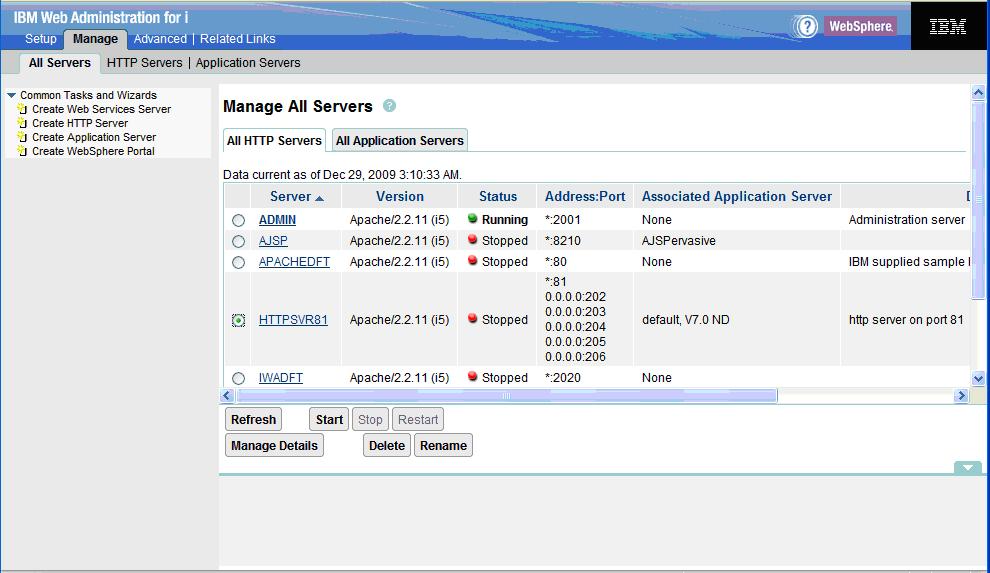
-
To create an HTTP Server, click on Create HTTP Server in the left-hand pane.
5.3 Creating a New HTTP Server Instance
You must create a new HTTP Server instance in which an instance of your JD Edwards EnterpriseOne configuration will run.
This section describes these tasks.
5.3.1 Creating a New HTTP Server Instance
To create a new HTTP Server instance:
-
Click on the Setup tab.
-
In the left pane, click on Create HTTP Server.
The Create HTTP server page displays in the right frame, as shown in the screen sample below.
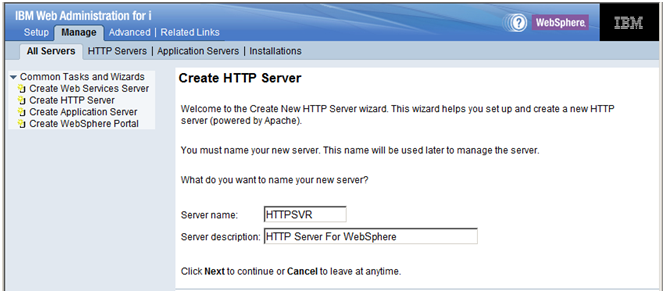
-
On Create HTTP Server, Welcome, complete these fields:
-
Server name
Enter a server name. For example:
HTTPSVR -
Server description
Enter a description. For example:
HTTP Server for WebSphere
-
-
Click the Next button.

-
On Create HTTP Server, Server root directory, you can accept the default value.
-
Click the Next button.
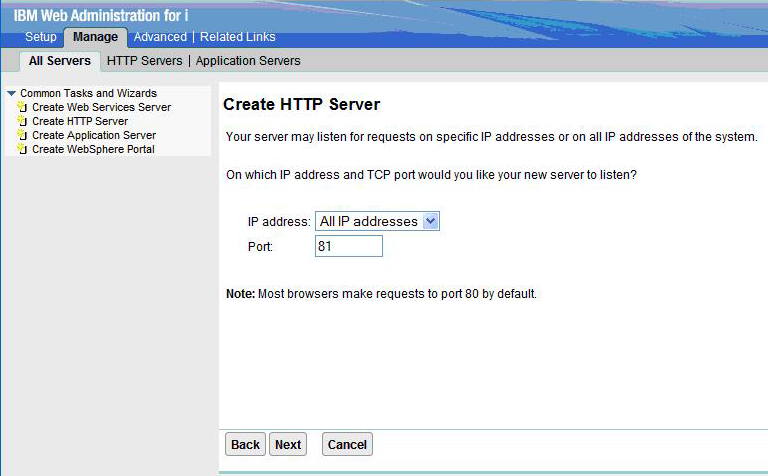
-
On Create HTTP Server, IP address and TCP port, complete these fields:
-
IP address
You can accept the default value:
All IP addresses. -
Port
Enter a port number for the HTTP Server. For example,
81.Note:
Since Port 80 is the default port and is already set up with a different web server, you must choose a different port number.Caution:
The port you entered in this field will not be available for use by the JD Edwards EnterpriseOne HTML Web Server. For example, if you plan to use port 84 for your JD Edwards EnterpriseOne HTML Web Server, for this HTTP server definition you must enter a port number other than 84.
-
-
Click the Next button.
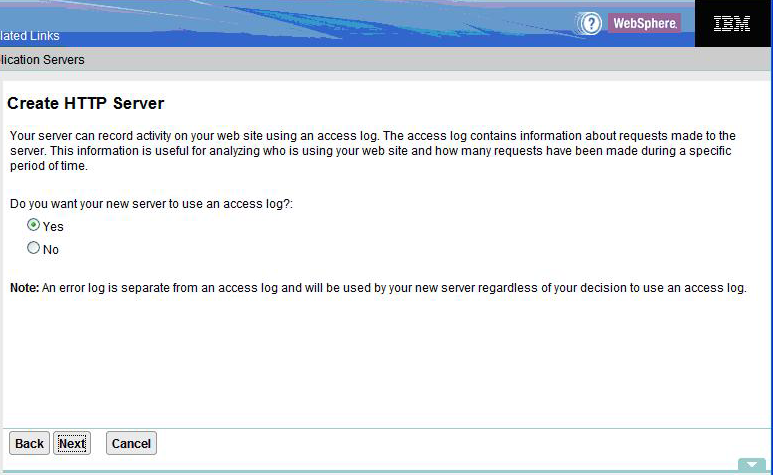
-
On Create HTTP Server, access log, you can accept the default radio button setting of Yes to specify you want your new server to use an access log.
-
Click the Next button.

-
On Create HTTP Server, keep logs, you can accept the default value
Keep, do not deleteto specify you want to keep the log files. -
Click the Next button.
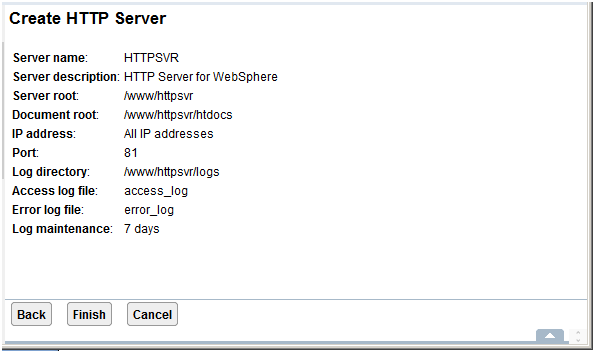
-
On Create HTTP Server, summary, review your selections and if acceptable click the Finish button to complete the creation of the HTTP Server.
5.3.2 Configuring the WebSphere Plug-in for a Standalone Profile
Note:
This process will not work if the WebSphere profile selected in Step On WebSphere Application Server, on the General tab, select the WebSphere Application Server to which you want to associate. below is a managed node.To configure the WebSphere plug-in for a standalone profile:
-
Click on the Manage tab.
-
In the left pane, click the WebSphere Application Server link.
Note:
If the link is not visible, use the slider bar to scroll down.
-
On WebSphere Application Server, on the General tab, select the WebSphere Application Server to which you want to associate.
-
Select the profile from the profile drop down box.
-
In the field Indicate which installed applications should be mapped to the selected Web server:, use the pulldown to select All Applications.
-
In the field Start All WebSphere application server(s) for the associated WAS instance when this HTTP server is started:, you can accept the default value of No in the drop down box.
-
Click the Apply button.
The program configures the plug-in for WebSphere, and returns to the first default screen.
-
Click the OK button.
The configuration can take several minutes to complete.
The above steps enable the HTTP server to pass requests to WebSphere.
-
Access the WebSphere Administration Console. For example: (for example at ), and click on the servers -> webservers.
http://<server_name>:9060/admin -
On the WebSphere Administration Console, click on Servers > Webservers.
The program should display the new webserver you created. By default, the server is named:
IHS_<HTTP_SERVER_NAME>If you following the recommendation in this procedure, the webserver is named:
IHS_HTTPSVR